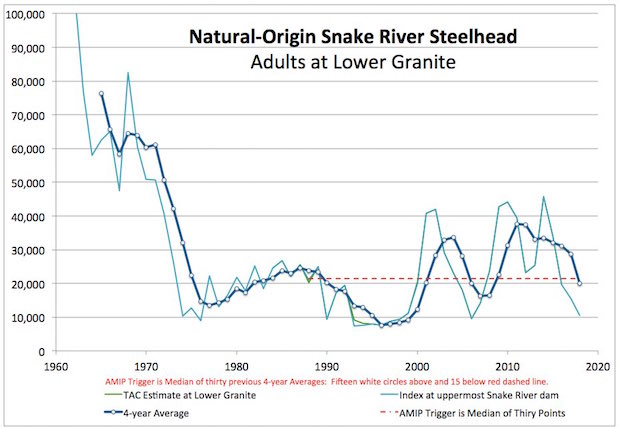forum
library
tutorial
contact

States Close Columbia River
to Steelhead Retention
by Staff
Columbian Basin Bulletin, August 30, 2018
|
the film forum library tutorial contact |

|
States Close Columbia River
by Staff
|
Run Downgraded 48 Percent From Preseason Forecast
 With an estimated 40 percent decline in the forecasted steelhead run upriver of Bonneville Dam, the states of Oregon and Washington closed the mainstem Columbia River to steelhead retention beginning Monday of this week.
With an estimated 40 percent decline in the forecasted steelhead run upriver of Bonneville Dam, the states of Oregon and Washington closed the mainstem Columbia River to steelhead retention beginning Monday of this week.
The states made the announcement Friday, Aug. 24 after the U.S. v Oregon Technical Advisory Committee downgraded the expected run of both A- and B-run steelhead from the 182,400 fish projected by TAC at the beginning of the year to 110,300 upriver steelhead, a number similar to last year's return of steelhead. TAC made that adjustment to the run at its Monday, Aug. 20 meeting.
However, Monday, Aug. 27, the same day the closure took effect, TAC again downgraded the run, this time to 96,500 upriver steelhead, according to TAC lead Stuart Ellis, who is also with the Columbia River Inter-Tribal Fish Commission. That's a 48 percent decline from TAC's preseason forecast.
The tally includes 69,000 clipped and 27,500 unclipped fish, Ellis said.
About half of the unclipped B-run can be hatchery fish, and a smaller percentage of the unclipped A-run, perhaps 10 to 12 percent can be hatchery fish, according to Geoff Whisler of the Oregon Department of Fish and Wildlife. He is also a member of TAC.
"Only time will tell on this steelhead run, but as of now it looks to be a very poor return," Whisler said. Looking at run sizes back to 1984, he said "there isn't a combined A/B-Index return less than 100,000. Closest was last year at 113,350."
With the Columbia River closure to steelhead retention from Buoy 10 to the Oregon/Washington border, the Washington Department of Fish and Wildlife also said it could close some Columbia River tributaries.
"WDFW is evaluating tributaries to determine if and where additional closures would occur, which would protect A run fish, plus assist with B run if the run does not materialize," said Ryan Lothrup, Columbia River fishery coordinator for WDFW.
He added that the A-run of steelhead is one of the lowest runs on record
"The steelhead run continues to be monitored which will play into how much more action would be considered," Lothrop said. "Last year's lower river tributary closures (including night) is the baseline we are reviewing to see what we learned from a regulatory aspect and providing meaningful protection to steelhead."
Drano Lake and Wind River have already been closed to steelhead retention and night fishing in Washington has been discontinued. Fishing for fall chinook and coho salmon on the Columbia River will continue.
Fishing gear used to catch salmon versus steelhead is typically different so there should be a reduction in encounters just based on not being available to harvest a hatchery steelhead, Lothrop said. When catching and then releasing steelhead, about 10 percent of the fish released are expected to die, he said.
"Many factors are clearly taking a toll on our steelhead populations right now, including difficult ocean conditions," Lothrop said. "We need to do what's necessary to protect these runs."
The new emergency fishing rule is posted on WDFW's website at https://fortress.wa.gov/dfw/erules/efishrules/
The revised forecast for steelhead is far lower than last year's actual returns of 113,500 steelhead, which was far below recent averages and prompted fishery managers to enact a series of rolling season closures to protect the steelhead as they moved upstream, said an ODFW news release.
Passage of steelhead at Bonneville Dam by August 28 is just 59,230 fish, 27 percent of the 10-year average of 220,163. Some 23,771 of this year's steelhead are unclipped, which is about 29 percent of the 10-year average of 83,087. Last year's run on this date was 72,090 with 25,887 unclipped fish.
"Steelhead returns are well below expectations and this latest update just doesn't support allowing the fishery to continue as is. I encourage people to explore other angling opportunities during this conservation closure period, and if a person does happen to intercept a steelhead it is critical that they do their utmost to ensure its survival by using best fishing practices," said Tucker Jones, manager of ODFW's Ocean Salmon and Columbia River Program.
In Oregon, the closure also includes the John Day River from Tumwater Falls downstream to its confluence with the Columbia. Oregon had previously adopted an angling sanctuary at the mouth of the Deschutes River, which remains in place.
The steelhead closure will continue through the end of 2018, although the states will continue to monitor returns and could lift some restrictions if the numbers improve, according to Jones.
ODFW lists best handling practices on Page 13 of the 2017 Oregon Sport Fishing Regulations. For more information and regulation updates, go to ODFW's Columbia River Zone online at https://myodfw.com/fishing/columbia-zone.
Related Pages:
Fall Fishing Opens To Lower Than Usual Chinook Returns; Season Includes Rolling Steelhead Closure by Staff, Columbia Basin Bulletin 7/28/17
Fisheries Managers Forecast 'Unprecedentedly Low' Summer Steelhead by George Plaven, East Oregonian, 5/22/17
Related Pages:
Fall Fishing Opens To Lower Than Usual Chinook Returns; Season Includes Rolling Steelhead Closure by Staff, Columbia Basin Bulletin 7/28/17
WDFW Restricts Fisheries On Columbia River, Two Tributaries To Support Steelhead Run by Staff, Columbia Basin Bulletin 8/17/18
Hot Water Temperatures Prompt Oregon/Washington To Close Deschutes, Yakima River Mouths To Fishing by Staff, Columbia Basin Bulletin 8/10/18
learn more on topics covered in the film
see the video
read the script
learn the songs
discussion forum
